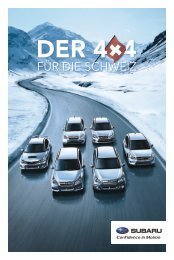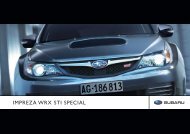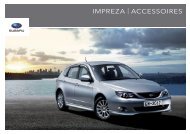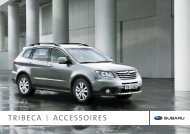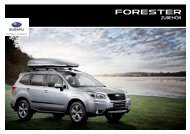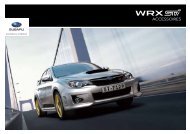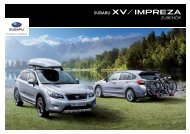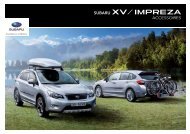Environmental & Social Report - Subaru
Environmental & Social Report - Subaru
Environmental & Social Report - Subaru
You also want an ePaper? Increase the reach of your titles
YUMPU automatically turns print PDFs into web optimized ePapers that Google loves.
Product Data<br />
Automobiles<br />
Model<br />
Legacy<br />
Outback<br />
Legacy<br />
B4 (Sedan)<br />
Impreza<br />
Sedan Forester R2 Sambar Van<br />
3.0R<br />
2.0i<br />
1.5i<br />
XT<br />
R<br />
VC<br />
Date sales began<br />
2004/2<br />
2004/2<br />
2003/9<br />
2004/2<br />
2004/2<br />
2004/1<br />
Vehicle type<br />
CBA-BPE<br />
CBA-BL5<br />
LA-GD3<br />
TA-SG5<br />
CBA-RA1<br />
LE-TV2<br />
Drive<br />
train<br />
Drive system<br />
Transmission<br />
AWD<br />
5AT<br />
AWD<br />
4AT<br />
AWD<br />
5MT<br />
AWD<br />
4AT<br />
2WD<br />
CVT<br />
4WD<br />
5MT<br />
Model<br />
EZ30<br />
EJ20<br />
EJ15<br />
EJ20<br />
EN07<br />
EN07<br />
Displacement (l)<br />
2.999<br />
1.994<br />
1.493<br />
1.994<br />
0.658<br />
0.658<br />
Engine<br />
Type<br />
Horizontally opposed 6-<br />
cylinder 3.0 L, DOHC,<br />
24-valve, variable valve<br />
timing +<br />
direct variable valve lift<br />
Horizontally opposed 4-<br />
cylinder 2.0 L, SOHC,<br />
16-valve<br />
Horizontally opposed 4-<br />
cylinder 1.5 L, SOHC,<br />
16-valve<br />
Horizontally opposed 4-<br />
cylinder, 2.0 L, DOHC,<br />
16-valve,air-cooled<br />
intercooler turbo<br />
(variable valve timing)<br />
In-line 4-cylinder,<br />
DOHC 16-valve<br />
(variable valve timing)<br />
Water-cooled in-line 4-<br />
cylinder, SOHC<br />
Weight (kg)<br />
15201570<br />
13301360<br />
1230<br />
14201440<br />
810<br />
930940<br />
Law on Promoting Green Purchasing adopted<br />
<br />
<br />
<br />
<br />
<br />
<br />
<strong>Environmental</strong> Information<br />
Exhaust emissions Fuel consumption rate<br />
Noise<br />
Air conditioner<br />
10-15 mode fuel economy (km/l)<br />
CO2 emissions (g/km)<br />
FY 2010 fuel economy<br />
Ref.<br />
standard achieved<br />
Regulations adopted<br />
Certification level<br />
of low emission vehicles<br />
CO (g/km)<br />
HC (g/km)<br />
NMHC (g/km)<br />
NOx (g/km)<br />
10-15 mode or<br />
10-15 + 11 mode<br />
regulation figures<br />
Ref.<br />
Low-pollution vehicle<br />
system designated by<br />
seven Kanto area<br />
prefectures and cities<br />
LEV-6 designation<br />
by six Keihanshin<br />
area prefectures<br />
and cities<br />
Regulations adopted<br />
Acceleration noise<br />
regulation figures (dB-A)<br />
Type of refrigerant<br />
Amount of refrigerant used (g)<br />
11.0<br />
214.4<br />
<br />
Year 2005 Standards<br />
U-LEV<br />
1.15<br />
<br />
0.025<br />
0.025<br />
(50% reduction in emissions<br />
<br />
from 2005 standards )<br />
17ULEV<br />
Year 1998 Standards<br />
76<br />
HFC134a<br />
400<br />
14.0<br />
168.5<br />
<br />
Year 2005 Standards<br />
U-LEV<br />
1.15<br />
<br />
0.025<br />
0.025<br />
(50% reduction in emissions<br />
<br />
from 2005 standards )<br />
17ULEV<br />
Year 1998 Standards<br />
76<br />
HFC134a<br />
400<br />
16.0<br />
147.4<br />
<br />
Year 2000 Standards<br />
Excellent low emission vehicle<br />
0.67<br />
0.04<br />
<br />
0.04<br />
(Excellent low<br />
<br />
pollution vehicle)<br />
LEV<br />
Year 1998 Standards<br />
76<br />
HFC134a<br />
500<br />
13.0<br />
181.4<br />
<br />
Year 2000 Standards<br />
Good low emission vehicle<br />
0.67<br />
0.06<br />
<br />
0.06<br />
(Good low<br />
<br />
pollution vehicle)<br />
TLEV<br />
Year 1998 Standards<br />
76<br />
HFC134a<br />
600<br />
24.0<br />
98.3<br />
<br />
Year 2005 Standards<br />
U-LEV<br />
1.15<br />
<br />
0.025<br />
0.025<br />
(50% reduction in emissions<br />
from 2005 standards )<br />
17ULEV<br />
Year 1998 Standards<br />
76<br />
HFC134a<br />
400<br />
16.6<br />
142.1<br />
<br />
Year 2002 Standards<br />
Excellent low emission vehicle<br />
3.30<br />
0.07<br />
<br />
0.07<br />
(Excellent low<br />
<br />
pollution vehicle)<br />
LEV<br />
Year 2000 Standards<br />
76<br />
HFC134a<br />
400<br />
Amount of lead used<br />
JAMA year 2005 target<br />
achieved (less than<br />
one-third of year 1996<br />
levels)<br />
JAMA year 2005 target<br />
achieved (less than<br />
one-third of year 1996<br />
levels)<br />
JAMA year 2005 target<br />
achieved (less than<br />
one-third of year 1996<br />
levels)<br />
JAMA year 2005 target<br />
achieved (less than<br />
one-third of year 1996<br />
levels)<br />
JAMA year 2005 target<br />
achieved (less than<br />
one-third of year 1996<br />
levels)<br />
JAMA year 2005 target<br />
achieved (less than<br />
one-third of year 1996<br />
levels)<br />
Design to improve recyclability<br />
Display of material Display of material<br />
symbols on plastic and symbols on plastic and<br />
rubber parts over 100 g. rubber parts over 100 g.<br />
Facilitation of removal of Facilitation of removal of<br />
air bags and rear lamp air bags and rear lamp<br />
Display of material<br />
symbols on plastic and<br />
rubber parts over 100 g.<br />
Easier to dismantle<br />
seats, instrument panel,<br />
and others<br />
Display of material<br />
symbols on plastic and<br />
rubber parts over 100 g<br />
Display of material<br />
symbols on plastic and<br />
rubber parts over 100 g<br />
Display of material<br />
symbols on plastic and<br />
rubber parts over 100 g<br />
Recycling<br />
Use of recycled materials<br />
Use of materials from<br />
used fishnet for intake<br />
mechanism parts and<br />
from clothing scraps for<br />
interior parts<br />
Use of materials from<br />
used fishnet for intake<br />
mechanism and from<br />
clothing scraps for<br />
interior parts<br />
Use of materials<br />
recycled from PET<br />
bottles for insulators<br />
and from used paper for<br />
vibration absorbing<br />
materials<br />
Use of materials from<br />
clothing scraps for<br />
interior parts and from<br />
used paper for vibration<br />
absorbing materials<br />
Use of materials<br />
recycled from collected<br />
bumpers, PET bottles,<br />
and clothing scraps for<br />
interior parts<br />
Use of materials<br />
recycled form clothing<br />
scraps for sound<br />
insulators and from<br />
collected bumpers for<br />
covers<br />
Matters for special mention<br />
Expand the use of<br />
easily-recycled olefin<br />
resin such as PP, TPO,<br />
and others<br />
Expand the use of<br />
easily-recycled olefin<br />
resin such as PP, TPO,<br />
and others<br />
Use of easily-recycled<br />
TPO plastic for<br />
instrument panel, door<br />
trim, and others<br />
Polyurethane seat pad<br />
is placed on top of the<br />
pan frame facilitating<br />
disengagement<br />
Frequent use of easilyrecycled<br />
PP plastic for<br />
instrument panel, door<br />
trim, and others<br />
Fit-in type glove box is<br />
fitted in the instrument<br />
panel facilitating<br />
disengagement



